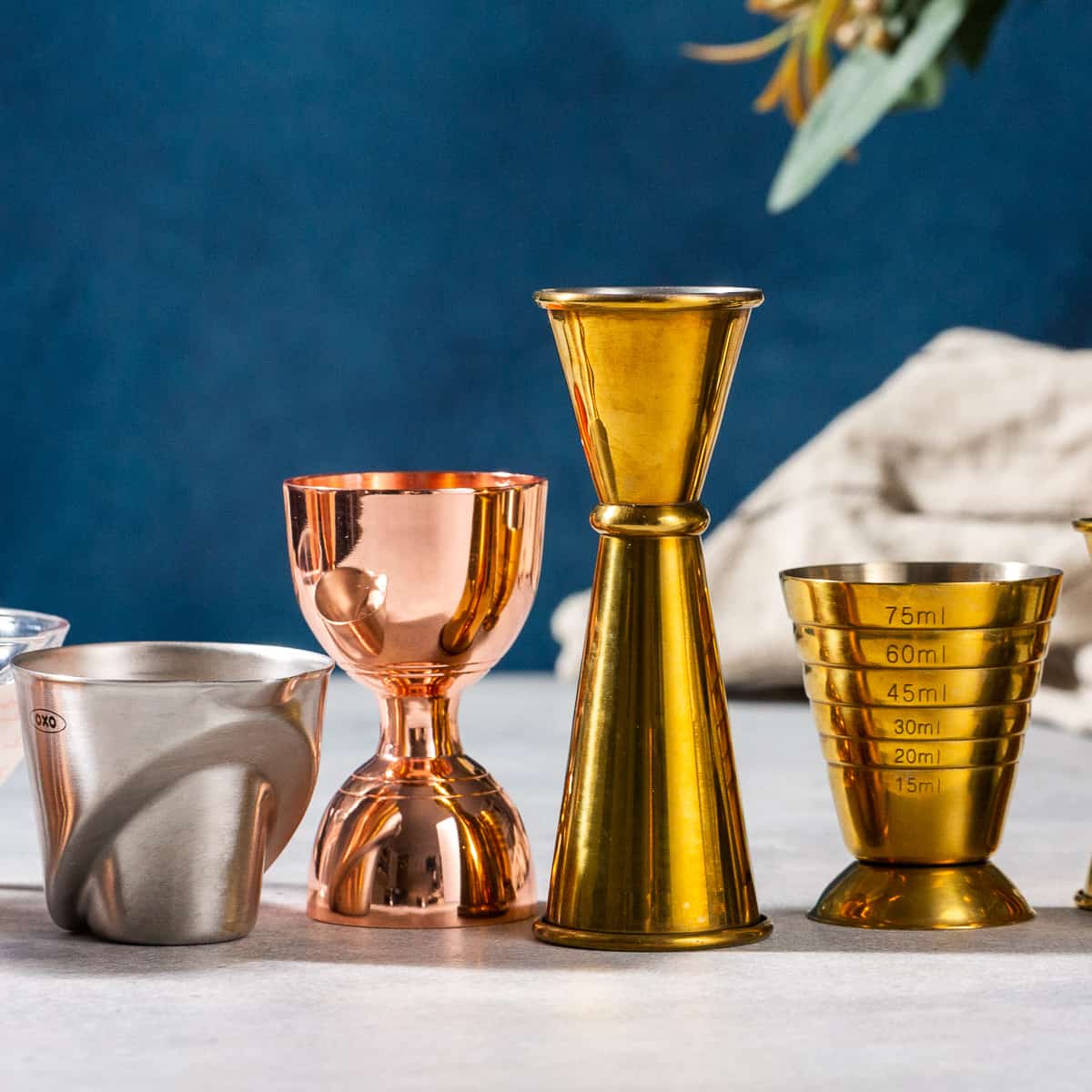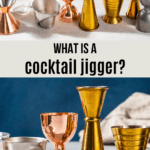One of my favorite parts of cocktail making is my jigger collection! Cocktail jiggers are such fun bar tools because they look cute, come in tons of different styles, and are super duper functional too. I am a huge proponent of measuring liquids when making cocktails. There is really no better way to get consistent drinks than to measure. That's where the jigger comes in! So what is a jigger, and why should you absolutely, definitely have one (or many) in your home bar?

Difference Between a Jigger and a Shot Glass
Sometimes people use the words jigger and shot interchangeably, but they are really two different things. The jigger is a cocktail measuring cup, and the sizes vary: they typically hold anywhere from 1 to 3 fluid ounces. By contrast, a shot is the equivalent of one unit of spirits, usually 1.5 ounces here in the U.S. (More on that later!)
So, the main difference is that a jigger is not actually a unit of liquid measurement. It's a measuring device, and the good ones will have markings on them to show how much liquid you just measured out.
I use a jigger in pretty much all my recipes, but they come in extra handy for more challenging layered cocktails like the Black and White Rum Cocktail. They are also really great for super precisely measuring spirits in stronger drinks, like the Little Italy Cocktail.
Measuring in Tablespoons
Let's chat about tablespoons for a quick sec. Exactly how many tablespoons are in an ounce? In the U.S., a tablespoon is equal to 0.5 fluid ounces, or 14.8 ml. But, in the U.K., a tablespoon is 0.5 Imperial fluid ounces, which is 15 ml exactly (0.51 U.S. fluid ounces).
Then in Australia, a tablespoon is considered to be 20 ml, or 0.68 U.S. fluid ounces! These discrepancies are why I typically avoid using tablespoons as a measure in my cocktail recipes, but stick to U.S. ounces and milliliters. (You can use the metric converter on all of my recipes to see the ml amounts.)
Most jiggers available in the U.S. will show U.S. fluid ounce measurements, and some will also show milliliters. I've only seen a few show U.S. tablespoons.
The History of Jiggers
In the early days of mixology, bartenders often used whatever they had on hand to measure alcohol. Recipes were often given in parts, "glasses" or "cups" (meaning the size of the serving glass, not the modern 8-ounce cup). This led to a lot of inconsistency and confusion, since nothing was standardized. As the years went on, bartenders began to develop more standard ways to measure and share recipes.
In 1893, Cornelius Dungan filed a patent for a double-ended bar jigger, which was more or less the same style as what we use today. The different ends have two different measurements for liquid capacity. It's unclear if he actually invented the design, or it developed over time, but the word "jigger" itself seems to have originated in the Northeast U.S. in the early 1800s. Unsurprisingly, a lot of the information around jigger history is fuzzy, and not much is documented.
Nowadays, things are more or less standardized in terms of measurements, although there are some important things to know about the different sizes of jiggers and converting recipes for different areas of the world.

Standard Jigger Measurements
Modern jiggers come in a variety of sizes, but the most common have cups with 1.5 ounces on one side and 0.75 ounces on the other. Recently, jiggers with 2 ounces on one side and 1 ounce on the other have become more popular. They're a little more versatile, since the inner markings also have the 1.5, 0.75 and 0.5 ounce measurement markings.
Measurements Around the World
Most jiggers in the U.S. measure in ounces, but that's not the case around the world. Many countries use milliliters, and have moved to the more easy-to-understand standard of rounding out their milliliters. So, typically, 1 U.S. ounce would translate to 30 milliliters.
Here are some common U.S. bar measurements and their metric translations:
| Fluid Ounces (U.S.) | Actual (ml) | Used in Metric System Bars (ml) |
| ¼ | 7.4 | 7.5 |
| ½ | 14.8 | 15 |
| ¾ | 22.2 | 22.5 |
| 5⁄6 | 24.6 | 25 (England standard - single shot) |
| 1 | 29.6 | 30 |
| 1¼ | 37 | 37.5 |
| 1½ (U.S. standard - single shot) | 44.3 | 45 |
| 1⅔ | 49.3 | 50 (U.K. - double shot) |
| 1¾ | 51.8 | 52.5 |
| 2 | 59 | 60 |
These may all seem pretty close, but proportions are important in mixology! (And even numbers make my brain happy!) You can find even more information about worldwide shot sizes in this Wikipedia article.
Types and Designs of Jiggers
There are a bunch of different jigger designs on the market, and it mostly comes down to personal preference! Before we get into the styles, the two main categories are the double-ended and the single-ended jigger. Here's a breakdown of the main types.
Japanese Jigger
This is one of the most commonly seen jigger designs in recent years. This double-ended jigger is tall and angular, giving a great view of the inside markings. The tall and thin style makes for really accurate measurements.

Bell Jigger
The double-ended bell jigger has more rounded shape, like two bells joined at the curved end. These jiggers look beautiful and are very stable, much less likely to tip over than the Japanese style. However, it is a little harder to get consistent measurements because of the wide bowl.

Angled Jigger
The single-ended angled jiggers are great for precise measurements, because you can look down into them and see exactly how much you poured. Their big downfall is in looks. Also, keep in mind that the metal version doesn't give measurements in milliliters, but only in U.S. tablespoons as well as fluid ounces. These jiggers are what I recommend for anyone with mobility issues.

Step Jigger
Another single-ended jigger style is this step jigger, also called a multi-level jigger. These have indented rings around them with the liquid volume measurements printed on the outside. These are great for stability and looks, although they are a little tricky to get the hang of for consistent measuring. (I personally keep forgetting which line means which measurement, because the numbers are on the outside!) Some of these jiggers have a small window in the side so you can measure more accurately.

Handled Jigger
A handled jigger can come in either a single or double cup style, and it just means that some sort of handle is attached to the side. This can be great for someone with mobility issues, or just as a personal preference.
Rollover Jigger
Although not as common in modern years, the rollover jigger is a beautiful and functional style of jigger. There are a ton of antique styles of this jigger. They rest on top of the mixing cup, and the bartender pours into the jigger and then flips it over so the liquid goes into the cup below. The main downfall of these is that pouring too much will make the extra liquid go directly into the drink, so they're not the best for accuracy.
Even More Ways to Measure Alcohol
Beyond the jigger, many bars have moved on to more technologically advanced ways to measure alcohol even more precisely. These methods are more common in the U.K. than the U.S., as alcohol units are more strictly regulated. These include the optic measure, where alcohol bottles are fitted upside down into a whole big setup. The bartender flips a lever, and a pre-sized measuring container is filled up with a single shot and then dispensed out into the mixing glass.
Another type of measurement is the measured pour spout, in which only a precise amount of liquid comes out of the spout when you pour. You can read more about these different ways in this Wikipedia article.

Further Reading
Want to keep going down the cocktail measuring rabbit hole? Check out these books to learn more!
- Liquid Intelligence by Dave Arnold - this is a must-have for any home bartender that really wants to get in deep to the nerdy side of cocktails. There is only a small section on jiggers, but the techniques and theory behind everything is so interesting to read.
- The Bar Book by Jeffrey Morgenthaler - the ultimate guide to bartending techniques. This book goes into all of the ways to use different bar tools and more, resulting in the best drinks possible.
- Meehan's Bartender Manual by Jim Meehan - this one is more geared toward professional bartenders, and goes deep into bar design and the details of running a commercial bar.
Looking for more cocktail recipes?
Subscribe to our newsletter and never miss a recipe! You'll get our free weekly email straight to your inbox with recipes, news and other goodies. Cheers! 🥂




Comments
No Comments